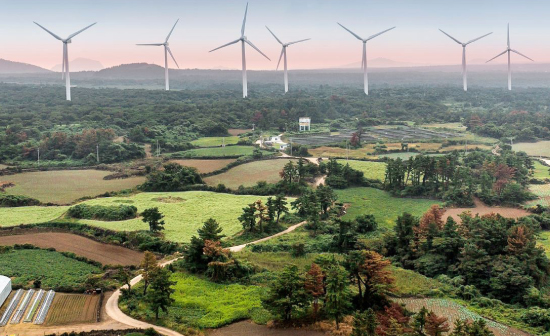[Sponsored Report] Korea Midland Power works for a greener energy future

A wind power plant in Sangmyung, Jeju. Komipo plans to expand offshore wind power in Jeju. [KOREA MIDLAND POWER]
Considering the low utilization rate of photovoltaic power generation, KO is pursuing a strategy of promoting large-scale water-based photovoltaic and industrial complex rooftop photovoltaic power generation linked to ESS (Energy Storage System). To this end, Komipo is actively exploiting the idle sites of the company and is developing large-scale photovoltaic businesses that utilize water-based photovoltaic power generation. It is also contributing to expanding renewable energy and to society at the same time by supplying renewable energy to marginalized areas. In March, Komipo donated 100 million won to social welfare facilities’ solar farm pilot projects.
Maebongsan Wind Power Plant repowering, which Komipo is working on, is a project to rebuild the existing Maebongsan wind power plant (8.8 megawatts) and increase its capacity up to 18 megawatts. It is the first large-scale wind power plant repowering project in Korea and is expected to contribute to expanding national wind power generation as a role model for efficiently improving the utilization rate of resources through repowering existing old facilities. In addition, the company plans to expand offshore wind power in Jeju and reclaimed areas off the west coast which have quality wind conditions, like Hallim-eup in Jeju. Komipo also plans to increase local acceptance of its projects by resolving complaints through community participation projects.
Komipo is also attracting attention in the renewable energy field overseas. Indonesia’s first offshore hydropower project, the Indonesian Wampu Hydropower Plant (45 megawatts), was completed last year. The ongoing Tanggamus Hydro Power Plant in Indonesia (55 megawatts) is expected to be completed this year. In addition to the 114 megawatt Siborpa project that is underway, it is expected to operate hydroelectric power plants that generate over 200 megawatts in Indonesia. In addition, the solar power business in Nevada (total 275 megawatts), which is being promoted with Sunpower, a global renewable energy company in the United States, is expected to start full operation after the completion of the first and second phase projects (150 megawatts).
By Kim Ha-eun [kim.haeun@joongang.co.kr]










with the Korea JoongAng Daily
To write comments, please log in to one of the accounts.
Standards Board Policy (0/250자)